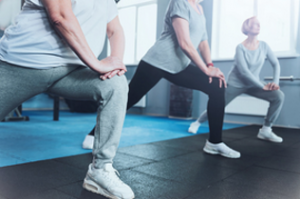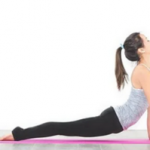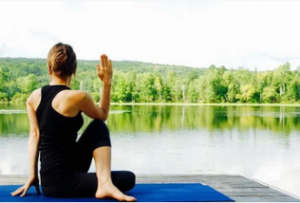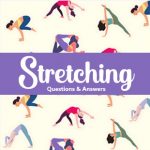
My Journey with Stretching
Welcome to Xiphoric Stretching! I am Kevin and I write alot of the content here. Just as a quick summary on background …
My mom was wanting to get more energy and work out some kinks and quirks so she could get back to her old lively self.
So my sister and I decided to start reading about easy ways to do this. Mom wasn’t into the whole gym scene, plus, she wanted something that fit her time schedule.
I found that simple stretching might be the answer for her, and she got onboard right away.
Then, I thought about the whole thing, and mom and sis encouraged me to do this website in 2020.
So that’s where we are and I may as well get started with my first thoughts.
A Beginner’s Stretching Guide To Body and Mind Fitness
Everyone deserves to live a happy life regardless of their age or gender. No one wishes to struggle with physical or mental illness that may hinder them from performing their daily activities comfortably.
However, in their quest to achieve the desired shape and stability, most people choose heavy workouts and ignore simple fitness exercises that target their mind and muscle movements.
As a newbie in the fitness world, this may be a dangerous route to take, considering how straining it is. That is why we introduce you to the mother of all workouts: yoga and stretching.
To be honest, I know way more about stretching than Yoga, but many people like to know about the similarities and the differences between the two.
Yoga and stretching have, for a long time, been considered as one fitness exercise. That is because, when approached from their benefits, these exercises lead to almost similar mental and physical effects.
However, according to most veterans, stretching and yoga are different exercises with distinctive benefits.
So, how do you get started with yoga or stretching to attain your desired physical and mental fitness? Here is everything you should know before designing your workout routine.
Understanding What Is Fitness
Before jumping to what is yoga and stretching and how to do them, it is vital to start with understanding the primary goal.
 Fitness may sound like a simple term that even those who have never attended any workout class can define. But ask different seasoned yogis or gym gurus and you will get different definitions.
Fitness may sound like a simple term that even those who have never attended any workout class can define. But ask different seasoned yogis or gym gurus and you will get different definitions.
According to Dave Costill, Ph. D., fitness is the ability to live a healthy life without feeling fatigued. The American College of Sports Medicine (ACSM) also defines fitness as the ability to maintain physical activity and live healthily.
Generally, being fit does not require you to have the strength of a weight lifter or the endurance of a marathon runner. It is all about being able to perform your daily activities without straining.
Types Of Fitness
When signing up for our yoga and stretching classes, we also advise you to understand the type of fitness you target to achieve. While fitness is a general term that refers to physical and mental stability, it is also classified into four groups based on how one exercises. These include:
#1 Cardiorespiratory Fitness
Cardiorespiratory fitness refers to heart, lungs, and blood vessel health. It is measured by the VO2 max (maximal oxygen uptake). VO2 indicates how efficiently oxygen enters the lungs, moves into the bloodstream, and is used by muscles.
The better the cardiorespiratory fitness, the more efficient oxygen moves from the lungs to the bloodstream and is utilized by the muscles. Also, an improved VO2 max means lower risks for heart disease and increased stamina.
#2 Muscular Fitness
Muscular fitness refers to both muscle strength ( how much load one can lift) and muscle endurance ( for how long one can lift the load).
Muscular fitness reduces as we age, leading to loss of balance and coordination, as well as general weakness.
To maintain muscular fitness, it is recommended to maintain a regular workout routine, which builds strength and endurance.
#3 Flexibility
Flexibility is simply the ability to move body parts without straining. It is mostly confused with fitness, though it primarily targets muscles and tendons – tissues that connect muscle bones.
Flexibility also reduces with age, leading to shorter muscles and stiffer tendons. Lack of flexibility also reduces the range of motion (ROM), leading to a lack of optimum movement of knees, shoulders, spine, elbows, and any other essential body part.
#4 Body Composition
Body composition is the percentage of the body made up of fat instead of muscles, bones, organs, and other non-fat tissues. According to ACSM, too much fat and fewer body muscles raise the risks of diseases and reduce the range of motion.
While several ways are used to measure body composition, the more accurate method is hydrostatic weighing. The method involves taking the weight when submerged in water and comparing it to dry weight (out of water).
How To Target All Four Groups of Fitness With Yoga And Stretching
 When talking about yoga and stretching, the first question likely to pop up in your mind is whether or not these exercises can target all four pillars of fitness.
When talking about yoga and stretching, the first question likely to pop up in your mind is whether or not these exercises can target all four pillars of fitness.
While it is challenging for beginners to explain the relationship between fitness and stretching or yoga, the best way to understand if yoga and stretching target all four pillars is through their definition.
First, ACSM suggests that one can easily achieve cardiorespiratory fitness by engaging in an intense exercise that raises their heart rate to at least 55% of their maximum heart rate.
Muscular fitness, on the other hand, can be attained by exercising each major muscle group with at least eight repetitions, while flexibility can be achieved through stretching.
So, the big question many people ask me is …
What is Yoga and Stretching?
Yoga is the collection of spiritual techniques and physical practices that aim to integrate the body, mind, and spirit and achieve a state of enlightenment or universal connection.
Yoga has different paths, defined by how one approaches the techniques and reaches the final goal.
 However, what remains common in all paths are the yoga postures (asanas), breathing techniques (pranayama), body gestures (Mudra), and internal cleansing (shatkarma). When combined, all these yoga aspects target to purify the body and cultivate life-force energy (prana).
However, what remains common in all paths are the yoga postures (asanas), breathing techniques (pranayama), body gestures (Mudra), and internal cleansing (shatkarma). When combined, all these yoga aspects target to purify the body and cultivate life-force energy (prana).
Stretching, on the other hand, is the physical exercise that puts body parts in a certain position for a specific time frame and targets to elongate and lengthen the muscle or muscle group.
The activity enhances body flexibility and elasticity, which increases range of motion (ROM).
How Do Yoga and Stretching Improve Fitness?
As seen in our guides, yoga and stretching are considered full-body workouts that target to enhance athletic performance.
That means, when done correctly, both yoga and stretching can improve muscular strength and endurance, flexibility, and cardiorespiratory fitness while reducing body composition.
However, the rate of increase in fitness and lung function depends on various factors, majorly the intensity of the exercise.
 Stretching makes the muscles larger and capable to extract and use more oxygen, which increases strength and endurance. As a result, the body trains to exercise longer and reach its maximal oxygen uptake (VO2).
Stretching makes the muscles larger and capable to extract and use more oxygen, which increases strength and endurance. As a result, the body trains to exercise longer and reach its maximal oxygen uptake (VO2).
Also, from the pranayama theory, regular breathing techniques increase lung capacity by enhancing the flexibility of the ribs, shoulders, and back. This makes the lungs and diaphragm expand more, which increases the VO2 max by making the blood to be more oxygenated.
Lastly, yoga and stretching tune the body and mind into harmony by coordinating all physical, mental, and spiritual actions.
This allows the body to partake in all daily activities, including exercises, and reach its maximum fitness capacity.
Are You Ready to Get Started?
To attain the desired physical fitness and body fluidity, you need to join our wellness laboratory; yoga and stretching classes.
The good thing about yoga and stretching is that anyone can participate and reap the above-discussed benefits. Whether you are looking to improve your muscle strength, cardiovascular health, or general fitness, our guides will have sorted everything out.
All you need is a positive attitude and a willingness to try and there, you have it, you are ready to go!
Read the Xiphoric Stretching Blog
There is a lot of material on the site and plenty to read when it comes to stretching.
Of course, you can use the Search button to find topics or use the links in the Navigation Bar across the top of the page.
Or you can just start with the Blog. That will show all the articles and guides written.

Be sure not to miss the Question and Answer Section, as others have asked the same things as you are probably wondering!
Oh, and one last thing. There will be many
new features for 2025.
I have them in the works now.
1. A new section for healthy recipes.
2. Simple, but effective challenges that anyone can do.
3. Meal plans that might help your journey to increased flexibility and mobility.
4. Downloadable Magazine
5. Higher online presence.
These are ALL in the works and you will see shortly!
All the best in your endeavor!
– Kevin